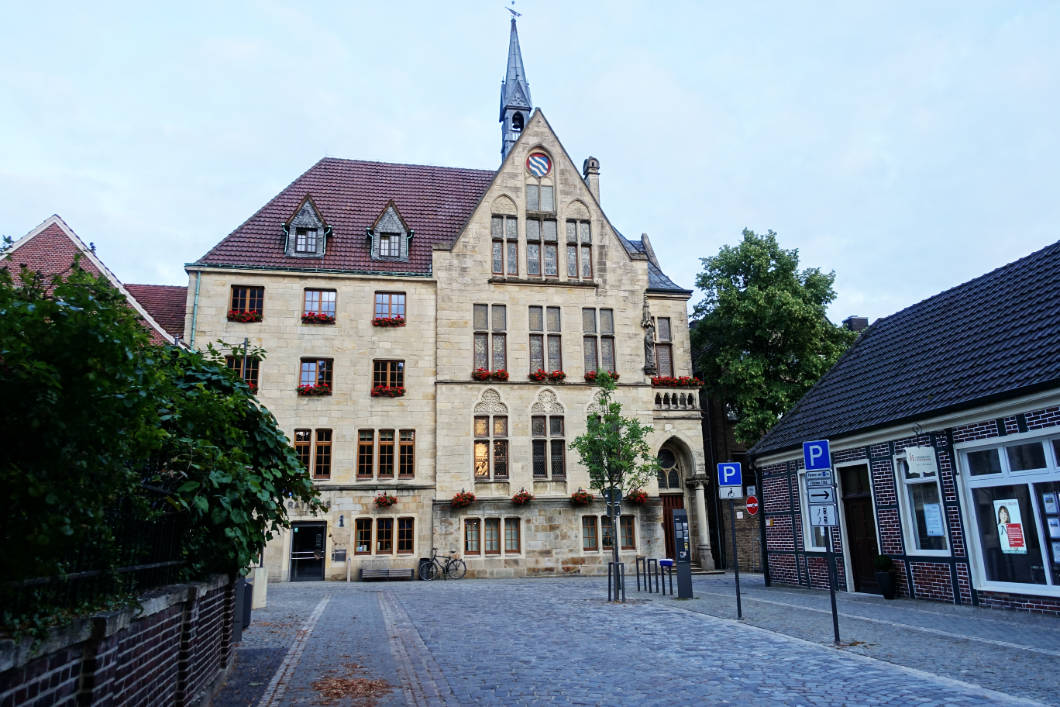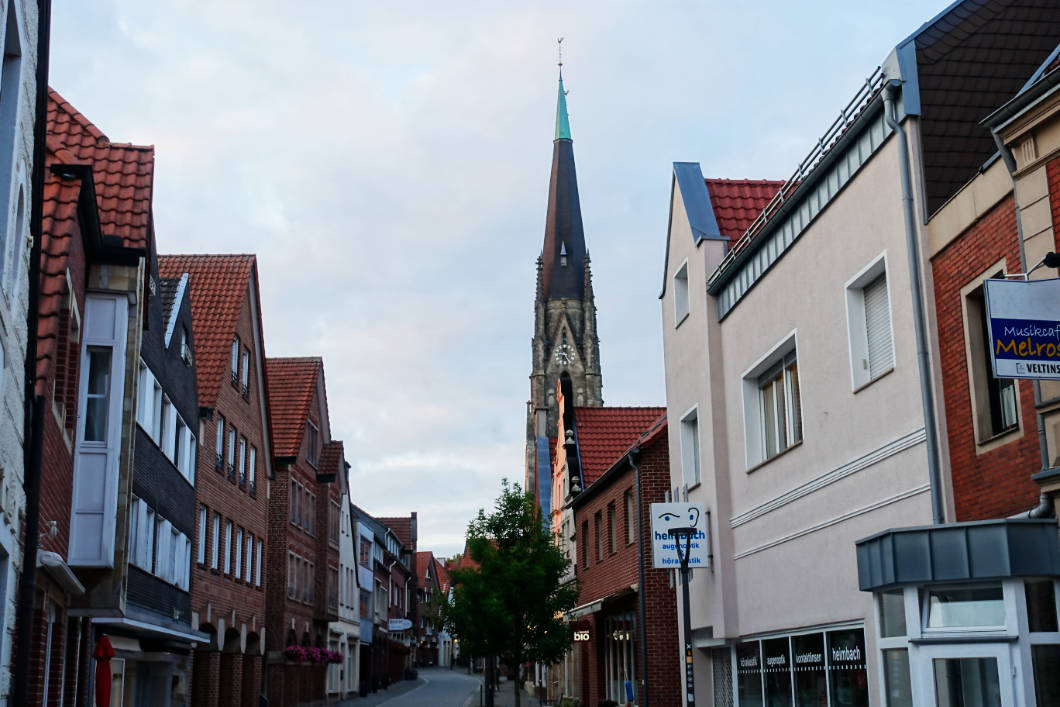Billerbeck in Münsterland is nestled in the gently rolling landscape of the Baumberge. Our discovery tour of the Münsterland by bike was to start from here. But before that, we took a look around the Ludgerus town.
On the tracks of Liudger
Ludgerusstadt, that didn’t really mean anything to me, but in the town you quickly find the explanation for this name.
In 809 Liudger, the first bishop of Münster held his last sermon here and died the next day in Billerbeck. Already during his lifetime he was highly respected and after his death he was venerated as a saint.
In many places in Billerbeck there are references to St. Liudger and so we went in search of traces.

Ludgerus Cathedral
You really can’t miss it, the cathedral in Billerbeck. Its towering spires provide an ideal orientation aid and the large building surprised me very much.
Where today stands the cathedral in Billerbeck, there was already a church for a very long time. Here was also for many years a place of pilgrimage for St. Liudger, with annual celebrations. On the 1000th anniversary of the death of the saint there were considerations to build a new church (1809). At first it was considered to enlarge the existing church. Many circumstances led to the fact that only in 1890 an architect was commissioned to draw up plans for a new building.

The construction of the cathedral in Cologne influenced the planning and so it was decided to build a building in the neo-Gothic style. Several buildings in the surrounding area had to make way for the project and in 1893 the foundation stone was finally laid.
The cathedral in Billerbeck is divided into a cruciform church building with two towers in the west. The building material used was Baumberg sandstone from the region, which has a very slight yellowish tinge. I am very surprised about the dimensions of the building. The dom is 56 meters long, 26 meters wide and the towers rise 100 meters into the air. For a small town already a really large church building.

Today the cathedral stands on the market square in the immediate vicinity of the neo-Gothic town hall. A walk around the cathedral is worthwhile. There are many interesting details to discover on the facade.
You should not miss the view into the cathedral. I liked it very much: bright, not too cluttered and the window design was exactly to my taste. Also in the windows you can find St. Liudger. In the main choir, a stained glass window shows the last mass of the bishop. The high altar is a special jewel. It is 7.50 meters high and hand-carved.
The destination of many pilgrims is the death chapel of St. Liudger on the first floor of the south tower. In a square room stands the Ludgerus altar, whose relief shows a scene of the saint’s death. In this room there is also a reliquary monstrance with the right foot of the saint. The stained glass windows in the chapel are also special. They were created in 1898 by a stained glass artist who also supplied the Vatican and show scenes from the life of Liudger.

Ludgerus fountain in Billerbeck
The Ludgerus Fountain is only about 15 minutes walk from the cathedral. There are numerous signs showing the way to visitors in Billerbeck. We paid a visit to the fountain during an evening walk.
The legend says:
Liudger once met a farmer on the Schürmann farm in the farming community of Bockelsdorf. The farmer complained about a lack of water. Liudger then took two geese and stuck their heads in the ground. He instructed the farmer to dig at that exact spot. The geese disappeared into the earth and came out again at the foot of the mountain (near Billerbeck). Since that time, a spring has been bubbling there.
The Ludgerus Fountain was first mentioned in a document in 1541. In the middle of the 20th century it was redesigned. There is now a monument to St. Liudger at the fountain. In a small chapel there is a sarcophagus-like pedestal with a stone reclining figure of the saint. It originates from a chapel that was built on the exact spot where, according to tradition, the death house was located and was later placed here.
Later, a memorial path was laid out. There are stones with inscriptions about the stations of life of the former bishop.
Anyone who visits the Ludgerusbrunnen should go here when dusk falls. The monument is illuminated and thus gives the fountain a very special charm.

St. John’s Church and St. John’s Square
If you walk through the pedestrian zone of Billerbeck you come to the Johanniskirchplatz. Here, surrounded by beautiful small storehouses, stands the Johanniskirche. The square with its lime trees and the small houses looked to me like a place from bygone times. In the evening, the lights were on in the houses and I was actually just waiting for a night watchman to ask me to go back into the houses and wish me a good night.

St. John’s Church is the oldest sacred building in Billerbeck and also one of the oldest churches in the diocese of Münster. Unfortunately, we have not experienced the historic ringing, here is still rung by hand.
St. John’s Church is much smaller than the cathedral, which is located in the immediate vicinity.
Based on archaeological research, it is now known that the present building is composed of four construction periods. The oldest proven building period consists of a Carolingian hall church, which dates back to the time of St. Liudger. It is even believed that the last mass of the bishop was held here.
The last structural additions must have been made in the 17th century. The mighty spire on the tower (78 meters high) dates from this time. If you look at it from below, you can see a bend that makes the top of the steeple look quite crooked.
Inside, two things impressed me. In the east there is a window that has been designed only in blue tones. The light that falls through it into the nave radiates a very special atmosphere. Exactly this atmosphere can be found in the tower chapel. Here is the baptismal font and here, too, the light shines in blue through a window. Beautiful!
Kolvenburg in Billerbeck
If you leave the Johanniskirchplatz through a small alley, you will quickly reach the Kolvenburg.

When I hear castle, I automatically think of towers, thick walls and knights.
Today, however, none of that can be seen when you stand in front of the Kolvenburg.
In the past, however, there must have been a square wall, a tower and a two-room house here, because the present building still contains remnants of them. The castle was built by knights from the von Billerbeck family, later various castle owners of the lower nobility lived here.
Today you stand in front of a beautifully restored multi-story house that houses a museum and cultural center.
Address:
An der Kolvenburg 3
48727 Billerbeck
Opening hours:
Tuesday – Saturday: 13-18 h
Sunday, holiday: 10-13 h and 13.30 – 17.30 h
Admission fee:
Adults: 3,50€
Discounts are offered.
Billerbeck theater mile
From the city center the theater mile leads to the open-air stage of Billerbeck. The route can be seen on the city relief, which stands in front of the town hall, and then leisurely walk the 14 objects with the different representations from the world of theater.
I would like to introduce some of the objects to you:
The gallows bird stands in front of the cathedral and forms the entrance to our path towards the open-air stage.
Christian Morgenstern published his Galgenlieder in 1905. It is a series of form and content childlike, language-playful poems.
Do you remember the story of Michel in the soup bowl? I loved this story as a child.
In this art installation, you can try putting your head in a soup bowl and experience what Michel did.
I have not tried it, but it has already irritated me…
Directly in front of the Billerbecker station is a pug with wings on a column. That this is an enchanted swan, I had to then but first google. I would never have thought of that.

I really liked the representation of Puss in Boots. It is located in the parking lot of the station, still a few meters from the open-air stage.











Leave a Reply